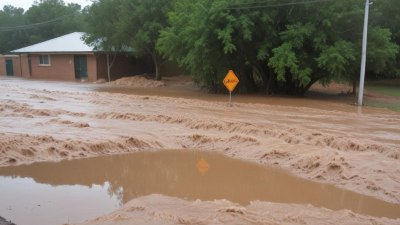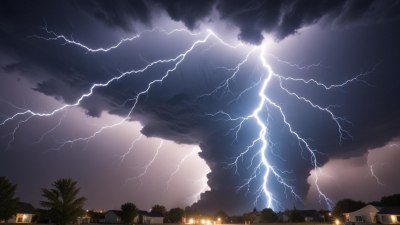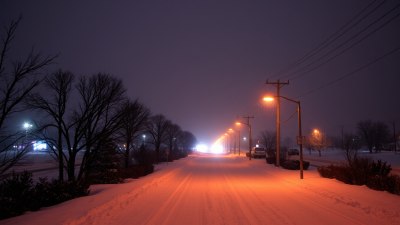Why Some Thunderstorms Cause Flash Floods
Explore the reasons behind flash floods caused by thunderstorms and their impact on communities.

This image was created with the assistance of Freepik
Flash floods associated with thunderstorms can occur with alarming rapidity, resulting in devastating consequences. Understanding why certain thunderstorms lead to flash floods is crucial for preparedness and safety. In this article, we will delve into the meteorological factors that contribute to flash floods, the nature of thunderstorms, and the necessary precautions that communities and individuals can take to mitigate risks.
Thunderstorms are defined as electrically charged weather systems characterized by rainfall, thunder, and lightning. They can range from single-cell storms to multi-cell clusters and supercell formations. While not all thunderstorms result in flash floods, those that do often share specific characteristics. The presence of heavy rainfall in a short period is the most critical factor leading to flash floods. In particular, thunderstorms that produce excessive rain in a localized area overwhelm drainage systems and lead to rapid water accumulation, resulting in floods.
The Role of Rainfall Intensity and Duration
Rainfall intensity and duration are the primary variables in determining the potential for flash flooding. Generally, intense rainfall (greater than 2 inches per hour) can saturate the soil quickly. When the soil can no longer absorb water, the excess rain flows into streams, rivers, and urban drainage systems. The cumulative effects of prolonged heavy rainfall can be disastrous, particularly in urban environments where impervious surfaces, such as asphalt and concrete, prevent water absorption.
In addition to intensity, duration is also a significant factor. A thunderstorm that maintains its intensity over an extended period (when compared to a short burst) is more likely to cause a flash flood. Continuous rainfall can lead to the saturation of soil, resulting in runoff and rising water levels in nearby waterways.
Topography and Soil Conditions
The topography of an area plays a crucial role in the occurrence of flash floods. Regions with steep slopes or mountainous terrain can experience rapid runoff due to the incline. Water that quickly flows off hillsides can rapidly move into valleys and low-lying areas, overwhelming rivers and creeks. The soil type and condition are equally important; compacted or rocky soils have lower permeability and can exacerbate runoff. Empty soil after a drought or a hard surface can lead to quicker flow rates into drainage systems.
Moreover, urbanization often leads to altered landscapes. Natural wetlands and green spaces are replaced with buildings and roads, which impede water absorption. As a result, cities frequently experience higher thresholds for flood risk compared to rural areas because of more concentrated stormwater runoff.
Atmospheric Conditions Contributing to Flash Floods
Atmospheric conditions also play a vital role in the development and impact of thunderstorms. Certain weather patterns can create environments conducive to severe thunderstorms capable of causing flash floods. Specifically, warm, moist air at the surface that rises into cooler air aloft can generate thunderstorms. When this warm, moist air encounters low-pressure systems, it can lead to rapid storm development.
Weather phenomena such as tropical storms or hurricanes can also result in exceptionally heavy rainfall and associated flash floods. These systems may create a setup that allows rain to fall over the same area for an extended period. The shear and instability in the atmosphere can lead to the development of supercell thunderstorms as well, which often feature strong updrafts and organized rotating cells capable of producing severe weather.
The Flash Flood Cycle
The flash flood cycle typically begins with a thunderstorm generating intense rainfall in a localized area. As runoff begins to accumulate, the water level in waterways starts to rise. If the rate of rainfall persistently exceeds the capacity of drainage systems, rapid inundation can occur, often within minutes to hours. Flash floods can develop so quickly that warnings may not reach everyone in time, which can lead to loss of life and property.
As floodwaters rise, they can reshape landscapes, damage infrastructure, and impact ecosystems. In urban settings, properties can be severely damaged or destroyed. Roads may be washed away, and vehicles can be swept into deeper waters. As a consequence, emergency service resources become strained, and recovery efforts become challenging.
Precautionary Measures to Take
To mitigate the risks associated with flash floods, it is essential for individuals and communities to take precautionary measures. The first step is awareness and education about local weather patterns and potential flood risks. Familiarizing oneself with the features of thunderstorms can help predict severe weather. Tune into local weather forecasts for warnings and watches regarding thunderstorms and potential flash flood risks.
Establishing an emergency plan that includes evacuation routes and communication channels is crucial for both individual safety and public readiness. Communities can also invest in infrastructure improvements, such as enhancing drainage systems, creating retention basins, and restoring natural waterways, which can help manage flooding impacts effectively.
Furthermore, emergency kits that include first aid supplies, non-perishable food, water, and necessary medications can prepare households for unexpected flooding events. Awareness of flood-prone areas and opting for alternative routes during heavy rainfall can also minimize risk.
The Role of Technology in Flash Flood Prediction
Advancements in technology have significantly improved our ability to predict and mitigate flash floods. Meteorological tools, including Doppler radar, weather satellites, and computer modeling, provide real-time data about rainfall intensity, storm movements, and future flood threats. Enhanced forecasting technology allows emergency services to issue timely warnings to the public, improving the chances of safety during storm events.
Moreover, community alert systems using text messages, social media, and weather apps can deliver vital information, particularly to those in areas at risk of flash flooding. By harnessing the power of technology, communities can adapt better to and prepare for potential flood events.
In summary, flash floods caused by thunderstorms are a multifaceted phenomenon influenced by meteorological factors, topography, and urbanization. Recognizing and understanding these dynamics can aid in developing effective strategies for both prevention and response. Communities must remain vigilant and proactive when it comes to weather readiness, as flash floods can have far-reaching impacts on people, infrastructure, and the environment. Through education, infrastructure improvements, and technological advancements, we can reduce the risks and enhance our collective safety in the face of severe thunderstorms and the potential for flash flooding.











